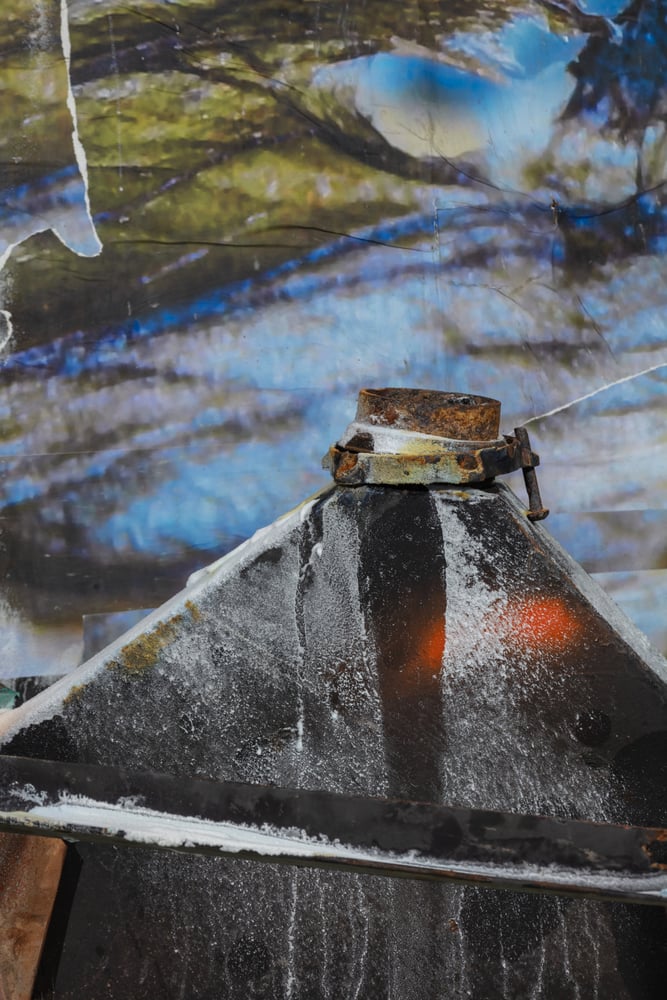
Multidisciplinary South African artist Bianca Bondi always touches on the history of the place where her work is exhibited. Taking the form of immersive installation, her exhibit evokes the natural environment but with a mystical, dystopian twist. Bondi is known for her use of salt as a key element in her faux habitats. The salt spurs a multitude of chemical reactions when in contact with the other materials. Her practice is a large-scale science experiment.
Bondi’s first solo show in the United States, titled A Preservation Method, is currently on view at the Dallas Contemporary. The exhibition examines Texas’s history of environmentalism, which led her to study the Highway Beautification Act (HBA), passed in 1965 by president and Texas native, Lyndon B. Johnson.[1] First Lady Claudia Alta “Lady Bird” Johnson, was known for her passion for environmental conservation and the HBA, also known as “Lady Bird’s Bill”. It was one of the most comprehensive laws to address outdoor advertising along the nation’s developing highway system. By limiting billboards, the law aimed to preserve native wildlife and the American landscape. Bondi’s exhibition at the Dallas Contemporary pays homage to the HBA nearly sixty years later.
Entering the gallery, before I see the work, I smell it—the glaring tang of salt and vinegar, like a pickle jar. Huge piles of white salt create a layered topography, complete with small vernal pools, which are common to Texas’s terrain, filled with transparent turquoise liquid. Also known as ephemeral pools, the microcosms support biological life and growth for a moment in time. Native Texas flora, which was dehydrated through a salt-preservation procedure, grow out of the pools, complete with delicate salt crystals adorning each leaf and stem.

Within the scenery, there are pieces of rusty steel beams and scrap metal from a junkyard. The artificial serenity contains post-apocalyptic undertones, relics from a world abandoned. If quiet, you hear the subtle auditory portion of the exhibition: the hum of roadways, sounds of cicadas chirping, water steaming, wind blowing. In the center of the gallery is the corpse of what was once a billboard—a direct nod to Lady Bird’s Bill. But this billboard is rusted to deterioration, a skeleton of the giant floating advertisement that once littered the skyline.
Over time, the installation changes. Salt absorbs the liquid, a mixture of potassium sulfate, vinegar, and food dye, which then oxidizes and crystalizes. The chemicals corrode and cleanse the metal simultaneously. Color from the chemicals migrate from the metal to the salt, manifesting as acidic yellow and blue-green patches. The dynamic and ephemeral nature of Bondi’s work allows her to relinquish control to her materials.
I can’t help but contemplate how Bondi’s exhibition highlights both the positive and negative realities of environmentalism in Texas. The use of salt addresses ongoing issues of wastewater contamination from oil fracking within the state.[2] The salt holds dual meaning, a symbol for healing and preserving, as well as an indicator of pollution. The work testifies not only to human destruction, but also to the resiliency of nature.

[1]“How the Highway Beautification Act Became a Law” U.S. Department of Transportation: Federal Highway Administration. https://www.fhwa.dot.gov/infrastructure/beauty.cfm.
[2] “Landowners fear injection of fracking waste threatens West Texas aquifers” The Texas Tribune. https://www.texastribune.org/2023/03/10/texas-permian-basin-fracking-wastewater-pollution-oil/.




